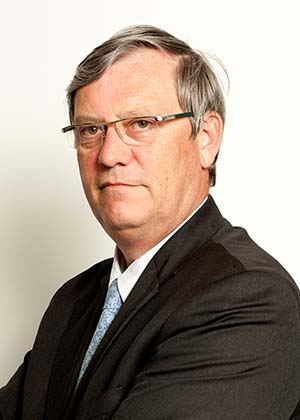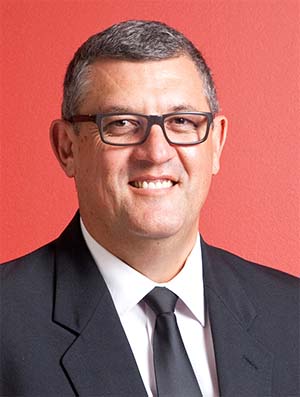Lexmark South Africa has gone through a period of re-invention, and emerged stronger than ever with a clear focus on a new strategy.
 It hasn’t been an easy year so far for the local subsidiary. The global organisation has been doing some restructuring and South Africa was one of the territories that came under the spotlight.
It hasn’t been an easy year so far for the local subsidiary. The global organisation has been doing some restructuring and South Africa was one of the territories that came under the spotlight.
“It hasn’t always been easy managing the South African office from 6 000km distance,” points out Arnaud de Seyssel, EMEA services director and EMEA MD. “We looked long and hard at South Africa when we started to optimise our EMEA structures.”
Before committing to a particular course of action, management considered a number of different models for the local office. One of these was to disengage completely and let a third-party partner run the South African operation.
“We investigated this model and even entered into discussions with local partners,” De Seyssel says. “There was a lot of interest from the local market, with partners keen to take on the Lexmark business. We got quite far down the road with discussions with one partner but, in the end, didn’t close the deal for various reasons.”
At the same time as this was happening, other strategies were being explored, he adds. “In parallel, we were also looking to continue running the business on-shore . I had some transparent discussions with the CEO about how we have a good business in South Africa. We recognise that the brand is important, but a presence is also important. What was missing from the setup was someone running the business who was completely immersed in the Lexmark business on a global scale.
“We got a stamp of approval from the corporation and the go-ahead to maintain Lexmark South Africa as part of the global business.”
The decision to retain a local office reflects a clear willingness from the corporation to grow and invest in the South African business, De Seyssel points out.
“We are determined to put the brand back on to the market, and continue with what we have done so well in the past – to be one of the major players in the local printing business.”
The South African management team has had to endure an unsettling couple of months, De Seyssel adds. But the fact that the team is still intact, and has bought into the new strategy 100% is testament to the strength of the Lexmark brand and its focus on people.
“In fact, one of the reasons we decided to retain the South African office was our local team,” he says. “During the period of uncertainty, the people in the local operation worked hard and remained committed to the brand.
“When we announced the direction we decided to take, they were relieved. They believe in the brand, and they have Lexmark DNA in their blood.
“This trust and loyalty from the team was very satisfactory for us; and was one of the things that tipped the balance in making a decision.
“I’m happy to say that the team can now see the light at the end of the tunnel.”
Part of the new-look Lexmark South Africa is some re-organisation in how the business operates.
“We have always had quite a siloed organisation, which is contrary to what we want: in South Africa this structure cannot work.”
In the past, different parts of the local company reported into their EMEA counterparts, so the South African operation didn’t always act as a cohesive whole.
Going forward, the new GM – who will be announced soon – will have full responsibility for the South African business, with all of the local managers reporting into him.
“We need to build an organisation where decisions can be take quickly, and that can react to market conditions on the fly,” De Seyssel explains. “Going forward, the new GM will have responsibility for running the whole South African business.”
While the main focus of the local office will be on the South African market, the local channel operation will still cover all of English-speaking Africa.
Apart from re-engineering the South African team and operations, there is also a new focus on the lower end of the commercial and consumer market.
“We are looking to extend the portfolio to address the below-$150 market,” De Seyssel says. “In Europe, we have launched a new series of devices, the 2 and 3 Series, that is an integral part of our new growth strategy.”
By adding this layer of printers to its offerings, Lexmark will effectively extend its addressable market by about 25%, he adds. “This move will let us gain market share and let us address more customers than ever before.”
At the same time, Lexmark will focus on growing its government and corporate business, where it already has a solid footprint.
“We are very present in banking and retail as well, and the team is focused on growing that business, particularly in managed print services (MPS).”
Lexmark is a strong contender in the South African MPS space, with 20 000 to 30 000 devices under management.
“This is a critical path to market,” De Seyssel points out. “We are building on a solid installed base and will implement new strategies that optimise the existing business while building new markets for the upcoming product lines.”
One thing that won’t change, De Seyssel stresses, is the Lexmark reputation for expertise and product reliability .
“The robustness of our devices is well known, but it is the team that makes the real difference. When you look back over the last 15 years, you will see many of the same faces in Lexmark’s South African office.”
Proven Lexmark technology
 It seems axiomatic that a printer vendor would be thriving in a world where information and communication is becoming more digital by the day.
It seems axiomatic that a printer vendor would be thriving in a world where information and communication is becoming more digital by the day.
But the move to digital is actually being largely driven by the printer industry, explains Jason Bennett, Enterprise Sales Director of Lexmark South Africa.
“Today, it is more about capturing, routing and managing information in the most efficient manner. Our smart MFPs are designed to capture, automatically classify and route documents, while extracting key searchable information for file naming, indexing.
“Through our managed print services (MPS) we help our customers to manage their fleets more efficiently, “We are always looking for ways to help our customers optimise their output fleet and identify new opportunities for paper reduction strategies,” Bennett says. “This is how we add value and retain our customers. The fact that we had a renewal rate of 95% last year speaks to the value we offer.”
Lexmark executes MPS in layers, starting with output infrastructure optimisation through industry-specific assessments for right-sizing of customers’ fleets, then applies proactive and predictive management services for visibility, continuity and control of the entire fleet. Finally, it uses analytics, best practises and a combination of output, content and process management technology to create automated workflow solutions that streamline cumbersome paper-dependent processes, resulting in improved access to information, enhanced productivity and the reduction of print.
Once in place, the managed environment becomes a conduit to unify print and digital information for streamlined processes and workflow, where our customers benefit with fewer devices, fewer pages, lower costs and improved knowledge worker productivity.
The company’s array of embedded solutions are designed to bring paper and digital information together and streamline processes, regardless of source to resolve print management inefficiencies, address security breaches and threats, and enhance business process automation while our installable security solutions take advantage of the Lexmark smart MFP platform to enhance the security of the device and customer environment. Depending on customer’s needs, these solutions can be implemented in the cloud, on a server or through “serverless” apps embedded on the smart MFP.
Professional services include assessments, consultations and implementation engagements, all designed to improve customers’ workflow efficiency and reduce operational costs, while Enterprise software services let customers take advantage of software features and technology through assistance with software upgrades, platform migrations and database conversions. Enterprise software deployment options ensure that our customers choose the software deployment and licensing options that are right for them. Lexmark offers a choice, including via the cloud as software as a service (SaaS) or on-premise deployment of its workflow and content management solution software.
“Basically our print solutions improve efficiency and reduce unnecessary printing; our capture solutions reduce costs and accelerate document-driven business processes; our full-spectrum security addresses print security threats; and our cloud services simplify infrastructure, streamline fleet management and enhance productivity for users and IT,” Bennett says. “But, of course, printers are still the foundation of the company.”
Cloud print infrastructure as a service offers a new approach to enterprise print
Lexmark has launched its Lexmark Cloud Print Infrastructure (CPI), a complete as-a-service solution that uses IoT and cloud technologies to take managed print services (MPS) offering to a new level.
With CPI, customers access a modern, secure print environment through a subscription service in which they pay for print capacity rather than owning and managing the physical infrastructure.
This new approach to enterprise print enables IT departments to reduce costs by removing infrastructure and management burden, while ensuring a higher level of user experience. For purchasing departments spending valuable time managing RFPs and complex billing, the offering provides flexible subscription pricing options.
The Lexmark CPI offering simplifies print, from acquisition to IT management and user support:
Data-based Print Fleet Design provides customers a more standardised and connected fleet of devices, while Cloud Print Management enables customers to eliminate the physical infrastructure required to support the print environment, including on-premises print servers, print server provisioning, driver deployment and user management
IoT/Smart Services are designed to deliver an always-on print environment using Proactive Consumables Management, Predictive Services, Proactive Device Notification and Live Data Analytics.
The Lexmark channel
 Lexmark South Africa operates with a two-tier channel model, and has no plans to change this going forward. The company sees its channel partners as an extension of our business and we are looking to invest and grow our channel.
Lexmark South Africa operates with a two-tier channel model, and has no plans to change this going forward. The company sees its channel partners as an extension of our business and we are looking to invest and grow our channel.
Channel manager Lawrence van Namen points out that hardware and supplies are distributed through Tarsus Distribution and Drive Control Corporation (DCC), while Kolok distributes just supplies.
The new sub-$150 devices will see the printer vendor increase its channel reach. “We need to develop our channel in the volume business,” Van Namen says.
“Today, we are extremely strong in delivering value-based products and solutions to our customers; as we extend our product portfolio, we will give our partners the tools to deliver on the volume side.”
Van Namen adds that this means Lexmark is actively aiming to recruit new resellers, and work with them of developing new routes to market.
“Once we launch products into the new price bands, this will open up opportunities for new players,” he says.
“The small to medium enterprise (SME) space is going to be key for us: we are working on strategies to help leverage the new opportunities.”
Channel partners are also being given access to new tools that will make them more effective in the connected world.
For instance, new cloud connectors will allow them to connect devices to the cloud and proactively manage them. “They will be able to manage their printer fleets with our cloud platform, without having to have a virtual private network (VPN) into the client site,” Van Namen explains.
New president and CEO for Lexmark

Allen Waugerman for Lexmark, Monday Feb. 12, 2018 in Lexington, Ky. Photo by Mark Mahan
Lexmark’s board of directors has unanimously selected Allen Waugerman as Lexmark president and CEO.
Waugerman joined Lexmark at its inception in 1991 and has served in a variety of leadership roles, including leading the company on an interim basis during the CEO search. Since 2016, Waugerman has served as Lexmark senior vice-president and chief technology officer.
He succeeds Rich Geruson, who left the company in November 2018.
“We are pleased to appoint Allen as Lexmark president and CEO,” says Mickey Kantor, chairman of the Lexmark board of directors. “He brings strong leadership, integrity, deep knowledge of technology and a track record of commitment to Lexmark’s success, making him the right choice to lead the company toward continued global growth.”
Waugerman holds a bachelor’s degree in electrical engineering from the University of Kentucky. He is a Dean’s Advisory Council member for the University of Kentucky College of Engineering and serves on the board of the YMCA of Central Kentucky.
“I am proud of Lexmark’s recent accomplishments, including the largest product launch in our history and the development of new solutions and services such as cloud-based as-a-service offerings,” Waugerman said. “I look forward to leveraging our strengths and proprietary technologies toward broad global growth strategies that will position Lexmark for success well into the future.”
